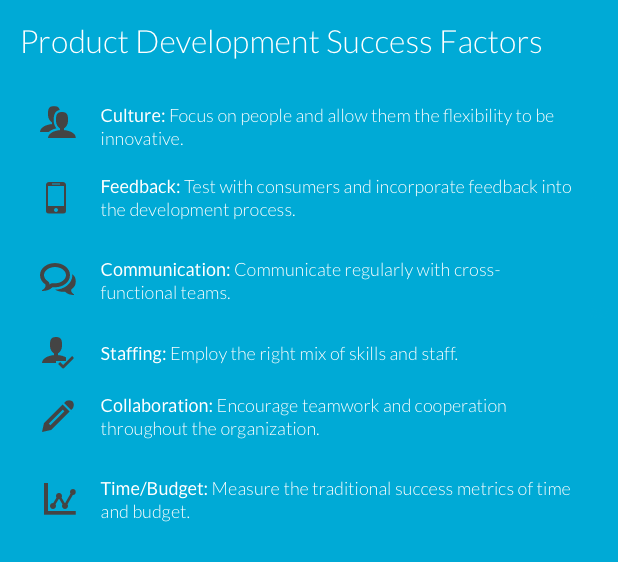Product Development Success Study Executive Report
Introduction
Business needs for new software product development have grown exponentially in recent years. Fueled by the growth explosion of technologies like mobile, social, cloud, and big data, many companies are finding that the successful creation of new software products is key to their ability to remain competitive and even survive. This holds true for companies whose core business has not traditionally involved software development. These companies realize that technology is now driving their business, and software products – either directly or indirectly – are defining touchpoints with their customers and influencing sentiment regarding their brand.
Given the importance of software products in advancing companies’ long-term growth, 3Pillar Global and the Center for Excellence in Service at the Robert H. Smith School of Business at the University of Maryland partnered to conduct a baseline study on the key factors and drivers behind creating successful software products. The study was conducted in September 2014 via an online survey of 204 professionals at the Manager, Director and Executive levels who are responsible for software product development in the Business Services, Education, Financial Services, Healthcare, Health and Wellness, Hospitality, Information Services, Media/Entertainment, Technology or Telecommunications industries.
Sixty percent of these respondents work for companies in the Mid-Market range that have annual revenues between $50 million and $2 billion. The results derived from this study formulated the Product Development Success Index (PDSI) and the six factors that comprise the PDSI.
Findings
The survey identifies six vital factors that influence a company’s ability to successfully develop new software products. The six factors that are identified in the survey are:

The factors are validated and weighted based on their ability to impact overall success, as perceived by senior professionals overseeing development functions. On average, companies score a 73 on the PDSI on a 0-to-100 scale. This may not be completely surprising, as achieving success in new software product development is a difficult proposition that requires a great deal of cooperation, collaboration, leadership, and talent within organizations.
Companies struggle with many aspects of software product development, but some factors are more critical to achieving success and should be a higher priority in improvement efforts.
Of all the critical success factors captured in the PDSI, the most important is the culture, which includes the ability to attract and retain top talent and provide career growth and appropriate rewards and recognition. Companies perform at a satisfactory level on this important dimension, but there is room to improve. Since this is the single most important factor in new software product development success, companies should prioritize boosting their performance in this area. A key challenge is creating well-defined ways to reward and recognize success.
The factor on which companies score worst is the area of Time/Budget Focus, which refers to a traditional focus on monetary and schedule control. This area has a relatively small overall impact, however, on product development success.
High-scoring companies report more positive tangible business outcomes, including higher revenue, better internal efficiency, superior brand reputation, and higher customer retention. This shows that the software product development process directly impacts overall business health.
Companies that are “highly successful” on the PDSI are not just more successful in achieving their business goals and metrics, but stand out in ways that offer direct clues as to why they are at the top of the pack.
The following summarizes some of the unique differences:
Successful companies are committed to an Agile approach.
The Agile development approach has received a lot of attention in recent years as a way to increase the efficiency and success of software product development in an organization. While there is no universal definition of Agile software development, this study considers seven distinct characteristics that are key indicators of an Agile approach and mindset, as shown in Figure 2. Agile thinking has become pervasive, with nearly nine- in-ten companies (86%) exhibiting at least one defining characteristic. Yet, no single company in this study exhibits all seven Agile characteristics, and less than 10% have at least five of the characteristics. In contrast, 26% of the “highly successful” companies demonstrate at least five characteristics, while none of those classified as “rarely successful” do.
Successful companies engage more resources for software product development.
For instance, one-third (34%) of companies in the “highly successful” group have over 1,000 employees working on new software product development, compared to just 17% of companies overall. Furthermore, “highly successful” organizations invest more on research and development, an average of $161 million per year compared to just $102 million per year by companies overall. The least successful companies, termed “rarely successful,” invest only $39 million per year.
Successful companies focus more on new sources of revenue.
A quarter (27%) of companies overall consider finding new revenue streams to be a more important new product development priority than increasing existing revenue streams; 62% consider them of equal priority. In stark contrast, the companies that are “highly successful” at new software product development are much more focused on finding new sources of revenue (53% consider it more important, compared to the 27% of companies overall).
Successful companies choose technology wisely.
Just one-third (37%) of software development professionals are “very confident” their companies are investing in the right new technology, but 76% of those in “highly successful” successful companies express this level of confidence.
Conclusion
This baseline study created a predictive model and index, which can be used as a tool to help determine and gauge how companies are faring in their ability to create new software products. The PDSI is an indicator to predict how companies are performing against software product development goals, as well as a variety of traditional business metrics, such as revenue, brand perception, and customer retention.
The factors that make up the PDSI provide a roadmap for companies to consider when making improvements to their software product development organizations. Key considerations for creating organizations that can build products successfully include:
- Establishing a culture where leadership truly champions innovation and provides a system that recognizes and rewards it. This may be challenging, but it is the important consideration when creating a successful product development organization.
- Collecting feedback from customers on new products is also critical, and companies must implement processes to continually incorporate that feedback and learning into subsequent development releases to have a real impact.
- Improving communication between and within development groups, as well as between technical leaders and business leaders. It is also imperative to ensure product objectives are clear from the start of the development process.
- Taking a broader view of new software product development. Companies must evaluate their financial investments in technology and people, as well as focus on product development strategies that generate new revenue streams, rather than increasing existing revenue streams.
- Employing agile software development practices. Agile practices require companies to focus on achieving critical dimensions noted in the report. Most companies exhibit at least one agile characteristic, but it is worthwhile to conduct a systematic review of how well a company adheres to the full set of seven characteristics identified in this study.
Evaluating their overall level of success and focusing on overcoming the obstacles needed to propel them forward more quickly when it comes to software product development and technology. This starts with building internal commitment and overcoming risk aversion, followed by committing financial resources to product development, and ultimately building the right staffing and skill set. The importance of being able to successfully build new software products will only continue to grow as consumers interact with companies more and more through digital touch points. Those companies that can quickly adapt to the ever-changing technological landscape will be best prepared to drive new revenue, protect brand reputation, and retain their customer base.
The Product Development Success Index was conducted in conjunction with the Robert H. Smith School of Business at the University of Maryland. The survey was conducted in the fall of 2014 and released to the public in 2015.
Recent blog posts

Stay in Touch
Keep your competitive edge – subscribe to our newsletter for updates on emerging software engineering, data and AI, and cloud technology trends.



